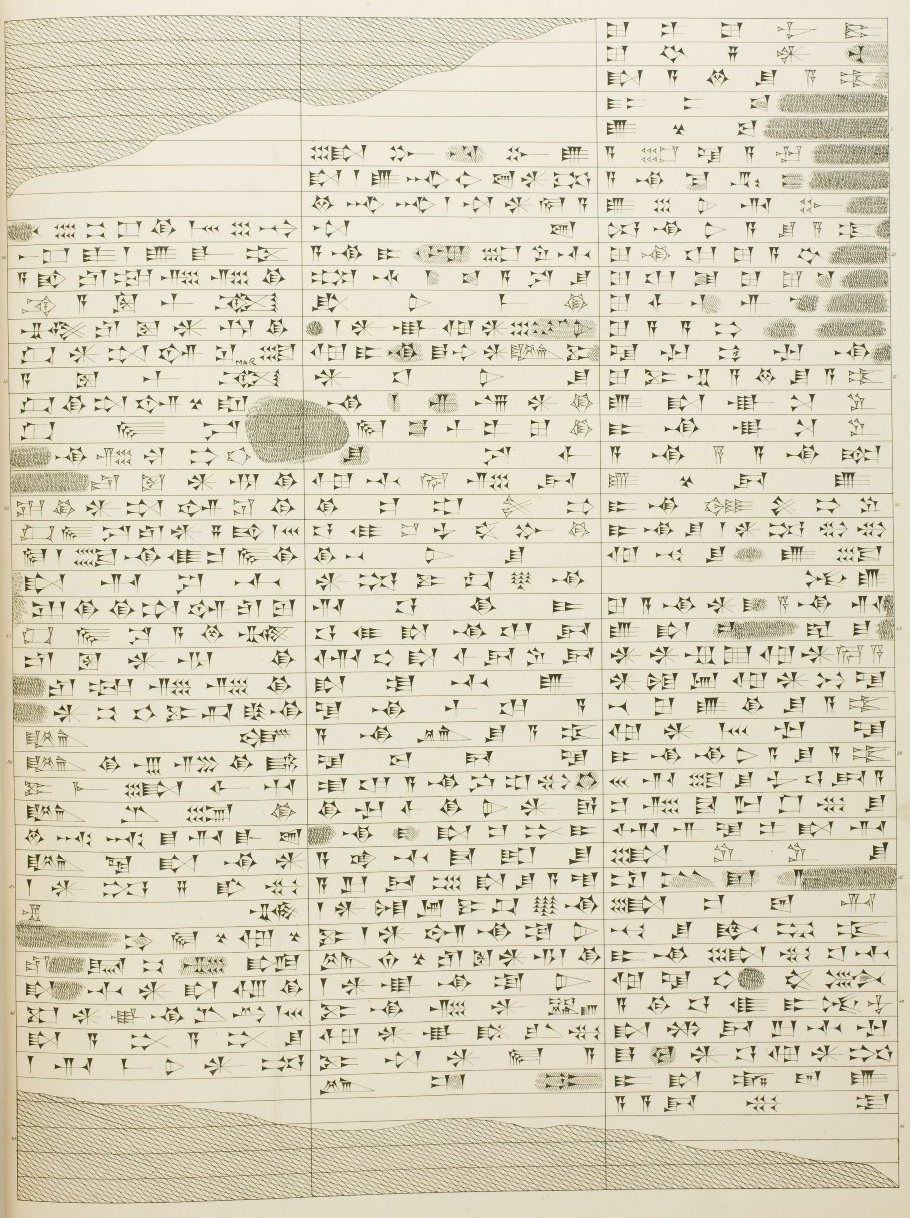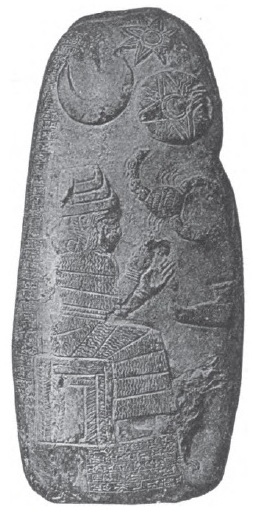|
Marduk-apla-iddina I
Marduk-apla-iddina I, contemporarily written in cuneiform as dAMAR.UTU-IBILA-SUM-''na'' and meaning in Akkadian: " Marduk has given an heir", was the 34th Kassite king of Babylon ca. 1171–1159 BC ( short chronology). He was the son and successor of Melišipak, from whom he had previously received lands, as recorded on a kudurru,Land grant to Marduk-apla-iddina kudurru Sb 22, excavated at Susa and currently in the Louvre. and he reigned for 13 years.''Kinglist A'', BM 33332, ii 13. His reign is contemporary with the Late Bronze Age collapse. He is sometime referred to as Merodach-Baladan I. Biography He claimed, like his father, descent from Kurigalzu and evidently kept court in Dūr-Kurigalzu itself because tablets found in the burnt ruins of the Tell-el-Abyad quarter which marked the later Elamite destruction of the city, are dated in the first two years of his reign. These include lists of garments received or distributed for the New Year, or '' akitu'', festival and ... [...More Info...] [...Related Items...] OR: [Wikipedia] [Google] [Baidu] |
List Of Kings Of Babylon
The king of Babylon (Akkadian: ''šakkanakki Bābili'', later also ''šar Bābili'') was the ruler of the ancient Mesopotamian city of Babylon and its kingdom, Babylonia, which existed as an independent realm from the 19th century BC to its fall in the 6th century BC. For the majority of its existence as an independent kingdom, Babylon ruled most of southern Mesopotamia, composed of the ancient regions of Sumer and Akkad. The city experienced two major periods of ascendancy, when Babylonian kings rose to dominate large parts of the Ancient Near East: the First Babylonian Empire (or Old Babylonian Empire, 1894/1880–1595 BC) and the Second Babylonian Empire (or Neo-Babylonian Empire, 626–539 BC). Many of Babylon's kings were of foreign origin. Throughout the city's nearly two-thousand year history, it was ruled by kings of native Babylonian (Akkadian), Amorite, Kassite, Elamite, Aramean, Assyrian, Chaldean, Persian, Greek and Parthian origin. A king's cultural and ethnic bac ... [...More Info...] [...Related Items...] OR: [Wikipedia] [Google] [Baidu] |
Enlil
Enlil, , "Lord f theWind" later known as Elil, is an ancient Mesopotamian god associated with wind, air, earth, and storms. He is first attested as the chief deity of the Sumerian pantheon, but he was later worshipped by the Akkadians, Babylonians, Assyrians, and Hurrians. Enlil's primary center of worship was the Ekur temple in the city of Nippur, which was believed to have been built by Enlil himself and was regarded as the "mooring-rope" of heaven and earth. He is also sometimes referred to in Sumerian texts as Nunamnir. According to one Sumerian hymn, Enlil himself was so holy that not even the other gods could look upon him. Enlil rose to prominence during the twenty-fourth century BC with the rise of Nippur. His cult fell into decline after Nippur was sacked by the Elamites in 1230 BC and he was eventually supplanted as the chief god of the Mesopotamian pantheon by the Babylonian national god Marduk. Enlil plays a vital role in the Sumerian creation myth; he sep ... [...More Info...] [...Related Items...] OR: [Wikipedia] [Google] [Baidu] |
Nazimaruttaš Kudurru Stone
The Nazimaruttash kudurru stone is a boundary stone (kudurru) of Nazimaruttaš, a Kassite king of Babylon, c. 1307–1282 BC (short chronology). It was found at Susa and is now displayed at the Louvre. Some kudurrus are known for their portrayal of the king, etc., who consigned it. Most kudurrus portray Mesopotamian gods, which are often portrayed graphically in segmented ''registers'' on the stone. Nazimaruttash's kudurru does not use registers. Instead, graphic symbols are used. Nineteen deities are invoked to curse the foolhardy individual who seeks to desecrate it. Some are represented by symbols, such as a goat-fish for Enki or a bird on a pole for Papsukkal, a spear-head for Marduk or an eight-pointed star for Ishtar Inanna, also sux, 𒀭𒊩𒌆𒀭𒈾, nin-an-na, label=none is an ancient Mesopotamian goddess of love, war, and fertility. She is also associated with beauty, sex, divine justice, and political power. She was originally worshiped in S .... Shamash ... [...More Info...] [...Related Items...] OR: [Wikipedia] [Google] [Baidu] |
Land Grant To Munnabittu Kudurru
The Land grant to Munnabittu kudurru is an elongated egg-shaped black limestone ancient Mesopotamian ''narû'' or entitlement stele (kudurru), 46.5 cm high and 20.5 cm wide, which details the reconfirmation of a gift of 30 GUR of land (around 750 acres) by Kassite king Marduk-apla-iddina I to his servant Munnabittu (a name meaning "fugitive, refugee"), son of Ṭābu-melû (probably a Hurrian name). It is significant because, in addition to portraying eighteen divine icons around its top, it lists forty-seven gods in its inscription, more than any other similar object. The stele Recovered from Susa during the French excavations under Jacques de Morgan at the turn of the twentieth century, excavation reference Sb 26, it is currently located in the Musée du Louvre. The text covers around three quarters of the surface of the sides with the top part engraved with a relief of religious iconography. It records the granting of a tract of land in the limits of the town of Ša ... [...More Info...] [...Related Items...] OR: [Wikipedia] [Google] [Baidu] |
Land Grant To Marduk-zākir-šumi Kudurru
The Land grant to Marduk-zākir-šumi kudurru is an ancient Mesopotamian ''narû'', or entitlement stele, recording the gift (''irīmšu'') of 18 ''bur'' 2 ''eše'' (about 120 hectares or 300 acres) of corn-land by Kassite king of Babylon Marduk-apla-iddina I (ca. 1171–1159 BC) to his ''bēl pīḫati'' (inscribed lúEN NAM and meaning "person responsible"), or a provincial official. The monument is significant in part because it shows the continuation of royal patronage in Babylonia during a period when most of the near East was beset by collapse and confusion, and in part due to the lengthy genealogy of the beneficiary, which links him to his illustrious ancestors. The stele The monument is a large rectangular block of limestone with a base of 51 by 30.5 cm and a height of 91 cm, or around 3 foot, with a broken top making it the tallest of the extant kudurrus and has intentionally flattened sides. It was recovered from the western bank of the Tigris opposite Baghda ... [...More Info...] [...Related Items...] OR: [Wikipedia] [Google] [Baidu] |
Male Head From Dur-Kurigalzu, Iraq, Reign Of Marduk-apla-iddina I
Male (symbol: ♂) is the sex of an organism that produces the gamete (sex cell) known as sperm, which fuses with the larger female gamete, or ovum, in the process of fertilization. A male organism cannot reproduce sexually without access to at least one ovum from a female, but some organisms can reproduce both sexually and asexually. Most male mammals, including male humans, have a Y chromosome, which codes for the production of larger amounts of testosterone to develop male reproductive organs. Not all species share a common sex-determination system. In most animals, including humans, sex is determined genetically; however, species such as ''Cymothoa exigua'' change sex depending on the number of females present in the vicinity. In humans, the word ''male'' can also be used to refer to gender in the social sense of gender role or gender identity. Overview The existence of separate sexes has evolved independently at different times and in different lineages, an example of ... [...More Info...] [...Related Items...] OR: [Wikipedia] [Google] [Baidu] |
Nazi-Maruttash
Nazi-Maruttaš, typically inscribed ''Na-zi-Ma-ru-ut-ta-aš'' or m''Na-zi-Múru-taš'', ''Maruttaš'' (a Kassite god synonymous with Ninurta) ''protects him'', was a Kassite king of Babylon c. 1307–1282 BC (short chronology) and self-proclaimed '' šar kiššati'', or "King of the World", according to the votive inscription pictured. He was the 23rd of the dynasty, the son and successor of Kurigalzu II, and reigned for twenty six years.According to the ''Kinglist A'' tablet, BM 33332, column 2, line 2, in the British Museum. His reign can be seen as the peak of the Kassite Dynasty, exemplified by his successful military campaigns against Assyria and Elam, the glyptic style of cylinder seals, the literature inspired by him (Hemerology for Nazi-Maruttaš), and his appearance in the period piece Ludlul bēl nēmeqi, which was set during his reign. Conflict with Assyria Nazi-Maruttaš faced a growing threat from the ascendancy of Assyria under Arik-den-ili and his successor Ada ... [...More Info...] [...Related Items...] OR: [Wikipedia] [Google] [Baidu] |
Adad-shuma-usur
Adad-šuma-uṣur, inscribed dIM-MU-ŠEŠ, meaning "O Adad, protect the name!," and dated very tentatively ca. 1216–1187 BC (short chronology), was the 32nd king of the 3rd or Kassite dynasty of Babylon and the country contemporarily known as Karduniaš. His name was wholly Babylonian and not uncommon, as for example the later Assyrian King Esarhaddon (681–669 BC) had a personal exorcist, or ''ašipu'', with the same name who was unlikely to have been related. He is best known for his rude letter to Aššur-nirari III, the most complete part of which is quoted below, and was enthroned following a revolt in the south of Mesopotamia when the north was still occupied by the forces of Assyria, and he may not have assumed authority throughout the country until around the 25th year of his 30-year reign, although the exact sequence of events and chronology remains disputed. Biography There is surprisingly little contemporary evidence for this king considering the purported length of ... [...More Info...] [...Related Items...] OR: [Wikipedia] [Google] [Baidu] |
Kurigalzu II
Kurigalzu II (c. 1332–1308 BC short chronology) was the 22nd king of the Kassite or 3rd dynasty that ruled over Babylon. In more than twelve inscriptions, Kurigalzu names Burna-Buriaš II as his father. Kurigalzu II was possibly placed on the Kassite throne by the Assyrian king Aššur-Uballiṭ I, reigned during a period of weakness and instability for twenty five years, eventually turning on his former allies and quite possibly defeating them at the battle of Sugagu. He was once thought to have been the conqueror of the Elamites but this now tends to be assigned to the earlier king of this name, together with the ''Chronicle P'' account. There is a gap of a little over forty years between his reign and that of his earlier namesake, Kurigalzu I and, as it was not customary to assign regnal year numbers, and they both had lengthy reigns, this makes it exceptionally difficult to distinguish for whom an inscription is intended. especially pages 205 - 207. A few royal inscript ... [...More Info...] [...Related Items...] OR: [Wikipedia] [Google] [Baidu] |
Uballissu-Marduk
Uballissu-Marduk, inscribed ''ú-ba-lí-su-''dAMAR.UTU, meaning “Marduk has kept him alive,” was a Babylonian accountant (''niğkas'') who rose to the rank of administrator (''sanqu'') in the Kassite government of Kurigalzu II, ca. 1332-1308 BC short chronology, whose principal sources are his two cylinder seals which detail his religious affiliations and his illustrious genealogy. Biography The earlier of his seals (pictured) is a chalcedony cylinder seal with eleven lines of text and one line of five insects. It provides a prayer to the goddess Ninsun and gives his position as “expert accountant.” His other cylinder seal,Cylinder seal BM 122696. lists four generations of his ancestors of which Arad-Ea “scholar of accounting” ( Sumerian: ''ummia niğkas'') is the first. His father, Uššur-ana-Marduk, had been gá-dub-ba é- ur? governor of Nippur, his grandfather, Usi-ana-nuri-?, GIR3.NITA2 kurdilmunki-a, “regent” or “viceroy” of Dilmun, ancient Bahrain. H ... [...More Info...] [...Related Items...] OR: [Wikipedia] [Google] [Baidu] |

_in_Akkadian.png)




